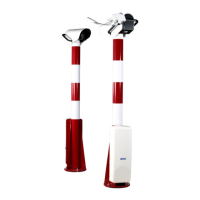User's Guide ______________________________________________________________________
42 __________________________________________________________________ M210667EN-C
Even though transmissometers are known as the most accurate visibility
sensors for the low and medium visibility ranges, the advantage of using
a forward scatter sensor is that there is no accuracy limit to the
measurement principle for high visibility readings. Furthermore, window
dirt contamination has only a minor influence on the accuracy.
The LT31 uses the auto-calibration method patented by Vaisala in order
to utilize the advantages of the forward scatter sensor measurement
principle to calibrate the transmissometer measurement. In practice the
PWD forward scatter sensor is used to indicate auto-calibration
situations, which are high visibility situations were a calibration factor is
calculated and applied to the transmissometer measurement.
An auto-calibration situation is recognized when all of the following
conditions apply:
- The forward scatter sensor detects a visibility situation with visibility
readings above the auto-calibration threshold, typically 10 km.
- The atmospheric situation is homogenous, meaning that the deviation
of the visibility reading is below a certain threshold for the past
observation period.
- No precipitation.
- No hardware failure detected in the transmissometer and forward
scatter sensor system.
The integration of the PWD forward scatter sensor into the LT31
transmissometer system enables auto-calibration at the installation site.
The transmittance measurement is recalibrated whenever the system
detects an auto-calibration situation.
The auto-calibration functionality compensates for all medium and long-
term drift effects due to window contamination and quality imperfections
of alignment.
Auto-alignment
The alignment quality of a transmissometer can lead to reduced
measurement performance. The fine alignment of classic
transmissometer products, in particular, is sometimes difficult.
A decreased quality in alignment due, for example, to a foundation drift,
leads to reduced receiver signal. The amount of signal loss creates
visibility reading deviations similar to the effect of window
contamination.
The Transmissometer LT31 includes an automatic fine-alignment
mechanism. To enable automatic fine-alignment, the transmitter as well

